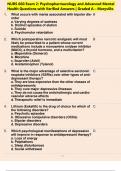Resume
Samenvatting Engels 3 Toegepaste didactiek (A Course in English Language Teaching, ISBN: 9781107684676 - Chapters 12, 15, 18, 19, 20)
- Établissement
- Artesis Plantijn Hogeschool Antwerpen (Artesis)
Dit is een samenvatting voor het vak Engels 3: Toegepaste Didactiek, van de lerarenopleiding secundair onderwijs Engels aan AP Hogeschool. Tijdens dit vak werden volgende hoofdstukken van het boek "A Course in English Language Teaching" (ISBN: 4676) behandeld: - CHAPTER 12: ASSESSMENT AND TESTI...
[Montrer plus]













